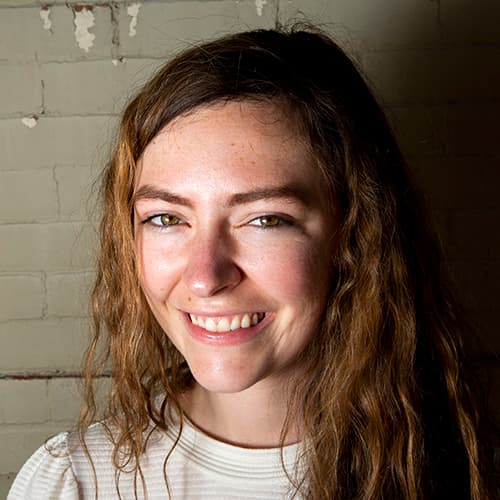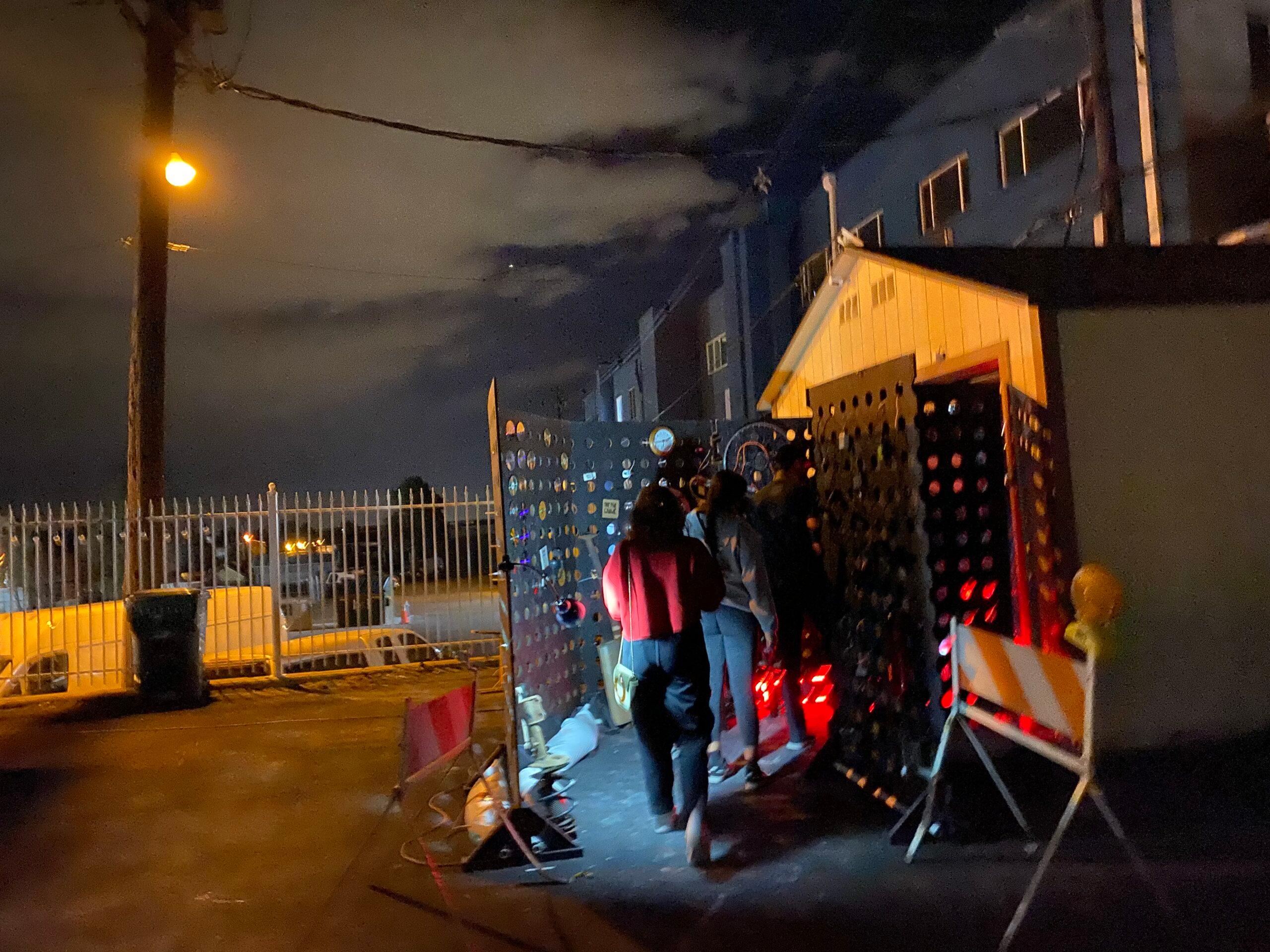It is once again that time of year when we lean into the darkness and choose, for a little while, to be afraid. We bring the macabre into our homes and our yards, opt into movies designed to frighten us, and immerse ourselves in fear landscapes via haunted houses.
For many, haunted houses are a cathartic experience -- a controlled, safe way to dive into subconscious fears. Once we step outside, we know that everything is OK.
But this year, it feels as if we're steeped in fear and anxiety about the pandemic, the upcoming election and what will come of it, forest fires, and of racially motivated violence and of rising tensions between political groups across the country. Fear is now all around us, inescapable.
At the same time, we now have fewer means of confronting those fears due to COVID-19 lock downs. How can we experience the thrill of haunted houses without enclosed spaces or too-close-for-comfort interactions with strangers?
No Place to Go is attempting to answer that question. Presented by Redline in partnership with 40 West Arts, No Place to Go is an immersive, socially distanced, multi-site "unhoused" haunted house. Participants remain in their quarantine pods and drive to five different installations where they interact with performers via a mobile app, from a safe distance, or through a protective glass barrier.
But NP2G doesn't just adapt the haunted house for pandemic times. It reimagines it altogether.
The project was created and directed by Serena Chopra, a writer, dancer and multidisciplinary artist; Kate Speer, a dancer, choreographer and community organizer; and Frankie Toan, a craft and DIY artist specializing in visual materials arts and immersive arts. Together, they conceived of an immersive, artist-created haunted tour, one that would tackle complex, everyday fears rather than the ones that typically manifest in haunted houses. They proposed a "queering" of the haunted house: an experience that preys upon fears that emerge in a society fixed in binary thinking and considers how different bodies exist in oppressive, inhospitable socio-political spaces. Rather than explore supernatural terror, NP2G critiques the very real terrors of the world we live in.
"The original idea was focused on this horror of the binary and the horror of binary choices," Toan said.
It's no accident that the show is premiering right before the election. No Place to Go draws upon anxieties born out of our political environment, in which we're forced to choose between two candidates "and then echoing that in a lot of queer theory and identity. Identity-based politics is this ideas of boxes. Like, you're this, you're that," Toan said.
In 2019, the team sent out an open call for artists to submit ideas for installations. In the end, they selected nine artists to design experiential environments that would act as the backbone of the tour. Each installation is an abstract concept that externalizes internal fears, creating an immersive fantasy world. There are no jump-scares, zombies or chainsaws here. Instead, the installations explore things like sleep paralysis, purgatorial states and our relationship with technology. All of these disjointed ideas are woven together through a narrative, written by Chopra and her partner, Kasey Ferlic.
"I think one of our values is queerness as a way for world-making," Speer said. She said the team had discussed how multiplicity is the core of queerness, and how, watching debates and opposing town halls, it's clear that our society is fixed in binary concepts.
"There are two choices," Speer said. "Our brains have been working in binary structures, at least in the U.S. culture and in Western cultures, for so long that it's hard to conceive of multiplicity. So it's a practice: the organic practice of trying to cultivate this collaborative project and hold nine different visions and synthesize them with a narrative."
On a cold October night, I decided to enter No Place.
The sun was setting in Lakewood when my five-person quarantine pod pulled up to the first stop: a café-bar called Mint & Serif. Coordinators encouraged us to grab snacks or coffee while we waited for our orientation. As we sat in our car, three other cars pulled up beside us. We would be embarking on the experience separately, but we were beginning it together.
We'd downloaded the NP2G app-designed by Bryan Costanza ahead of the event. An organizer walked up to the driver-seat window and gave us a secret code to enter into the app, which gave us directions to each stop on the route: five abandoned storefronts, shops and window displays through which we could watch performances safely through a barrier, all within a two-mile area within Wheat Ridge and the 40 West Arts District.
The app also played narration voiced by James Brunt, whose voice guided us through the "no place," weaving together the artists' disjointed ideas and fears into a cohesive -- if absurdist -- narrative. A spooky score by Mike Clark provided the soundtrack to our journey as we drove from installation to installation, and at each stop, the app offered contactless, choice-based interactions with the installations.
Chopra said the story has an atmospheric arc rather than a linear one, with different elements, such as repeating characters, repeating phrases and repeating fears, to anchor audience members. When Chopra saw common threads in the installations, she wove them into the narrative. One of the things that came up repeatedly was the idea of surveillance, so she wrote that into Brunt's narration.
"It's like listening to a radio program, but in a dystopian 'no place,'" Chopra said. "There's not actually a location for this 'no place.' It's just everywhere you are. You can't escape it because you're always being surveilled."
The narration also addresses the pandemic. Chopra said she was initially afraid to touch it, worrying that it would be too painful a topic for visitors to immerse themselves in.
"It's just already so terrifying," she said. "We didn't want to put people in a state of trauma"
She said they thought of how to reference the pandemic in a lighter way.
"We came up with some ways to integrate quirky little advertisements," she said. "I have a paparazzi dream database that gives you dreams to dream about. And there's a quarantine upgrade where you can get quarantine dreams."
Those ads played as we headed to our first stop on the tour: "A Liberace Dream." The installation is based out of an abandoned storefront in a strip mall. We entered an expansive space, which, per the artist statement, represents a version of purgatory. In the center of the room, a stage outfitted with a piano and rows of candelabras glowed purple. Liberace stood, facing away from us, in a white cloak, as archived footage of interviews from his lifetime played behind him on loop. We watched as he began to perform, slamming on the piano, stepping away from it, grabbing a sword and seeming to walk a tightrope, until his movements became more and more erratic. Liberace returned to the spot he started in, buried his head in his arms, and leaned upon the piano. He then repeated this four-minute routine on a loop for all of eternity.
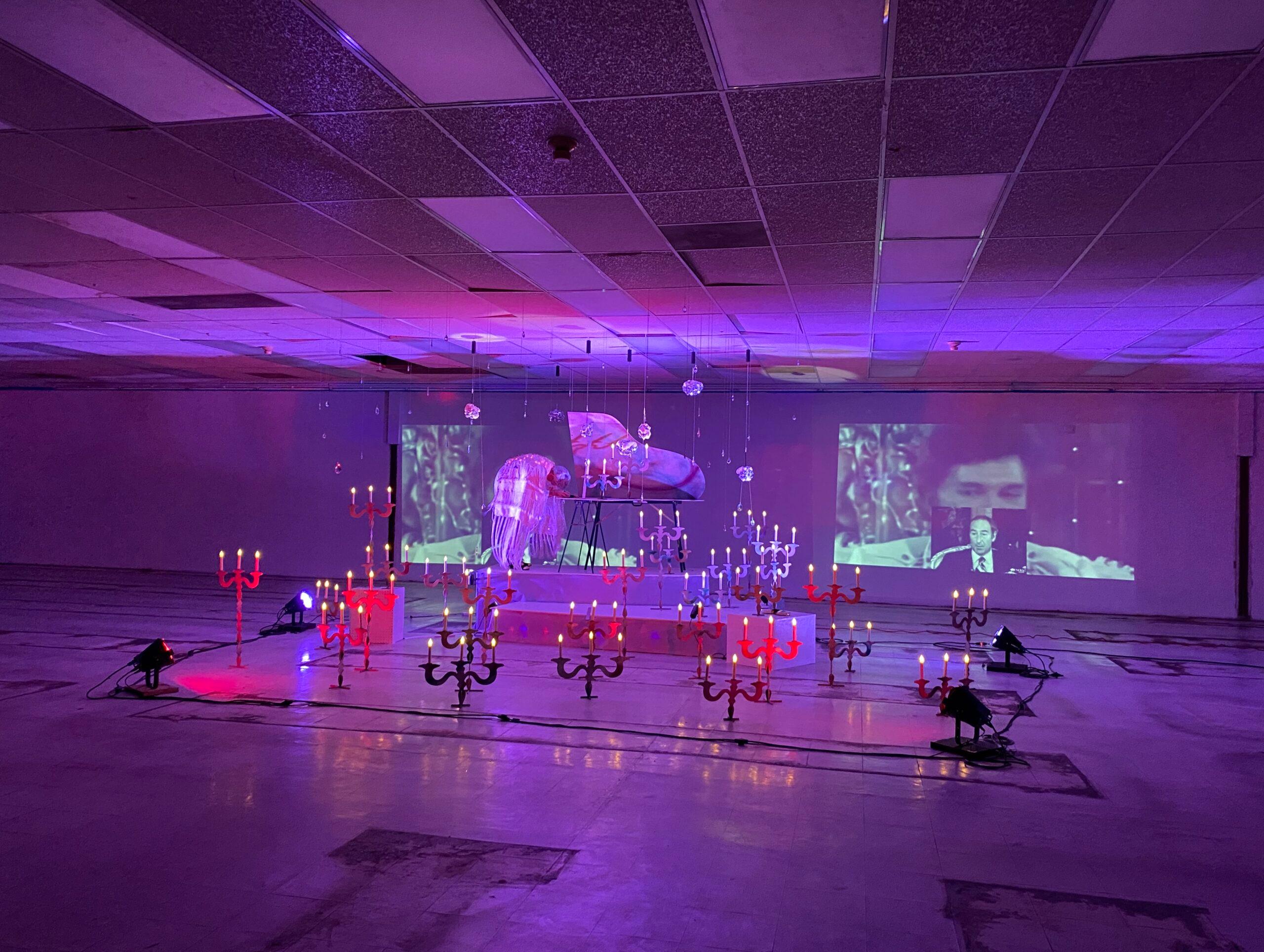
From Liberace's purgatory, we plunged into a state of sleep paralysis, walked to the outer limits of the twilight zone, and drove on to the "Surveillance Spa," where we convened with a medium, speaking to her through a glass barrier, answering questions about our spiritual experiences and trying to connect with unseen forces as inflatable sculptures swelled and contracted around her.
We moved to a room filled with four abstract sculptures and were made to choose the one that represents our bodies. We were sent to "The Waiting Room," a sterile space outfitted with outdated technology and early 2000s-inspired décor, where we filled out a questionnaire on the app (each question was multiple choice and increased in urgency as we went down the list) while we waited to be seen by the virtual secretary, who told us, repeatedly, to "please wait."
After waiting as long as we could, we moved on to the "Data Assimilation Base," where a cyborg of chords and human figures convulsed frighteningly before us in a bed of decay. We returned at last to the café, and through the back patio we entered "The Overwhelm." There, we were confronted with color and noise as a clown tossed objects at us and berated us for failing to catch them. We entered a "Photo Booth" inside the café, where we stumbled in the dark as an unseen photographer commented on our appearance and asked us to pose for photos.
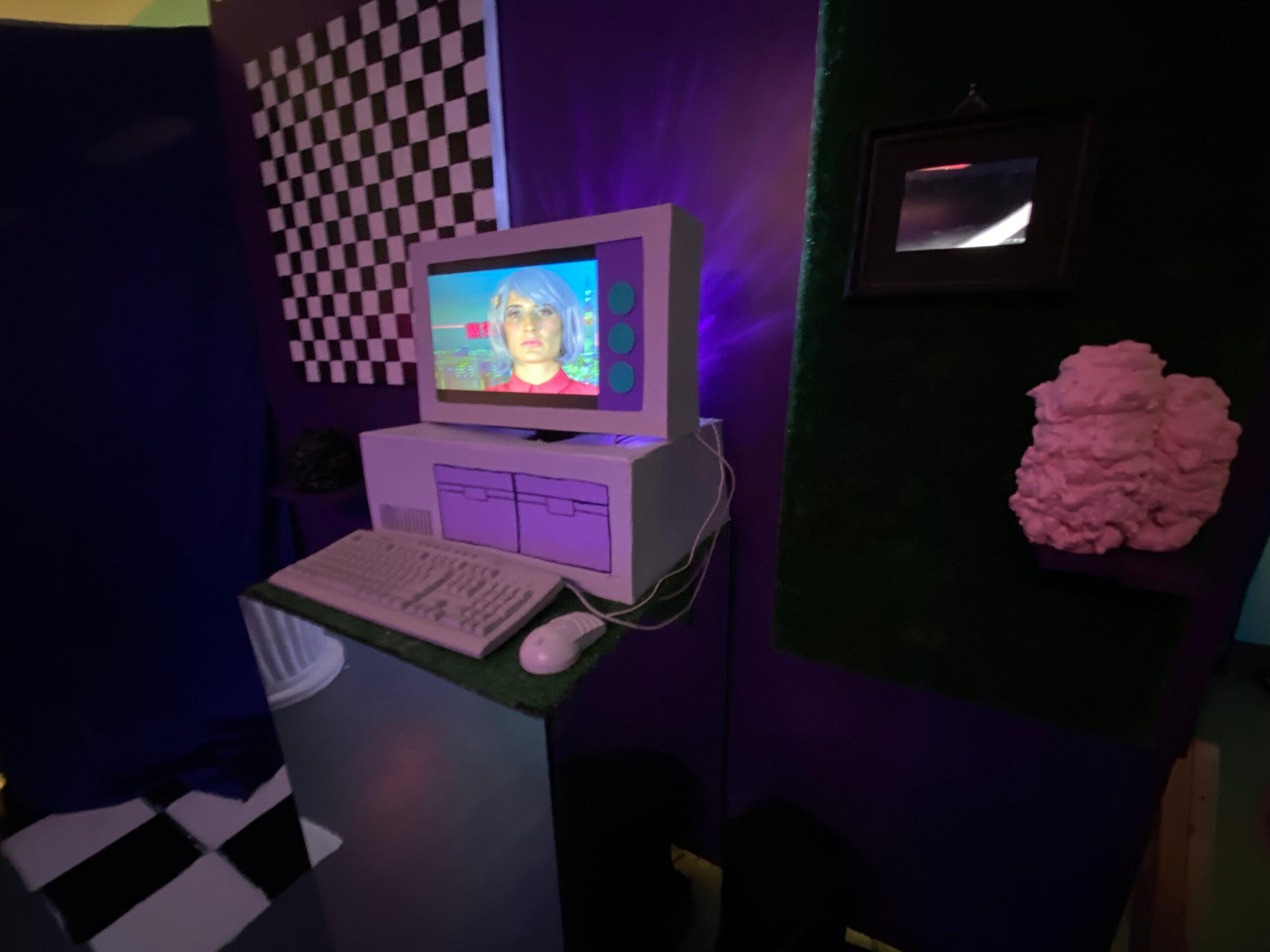
Throughout all of this, as we drove down dark and unfamiliar streets, past strip malls and motels and neon lights that might belong anywhere in the country, we thought we could see clowns wandering around between the installations. We returned to our car and left the "no place" behind, returning to the bright lights of our own haunted world.
No Place to Go was inspired in large part by a project called Killjoy's Kastle: A Lesbian Feminist Haunted House.
Created by Allyson Mitchell and Deirdre Logue, the project played upon icons and figures relevant to feminist and queer history. When Toan learned about that project, they became interested in the notion of a queered haunted house, and in 2018 brought Speer and Chopra on board. Together, the three of them dreamt up their own concept, one built around the idea of Utopia, as it is understood in José Muñoz's Cruising Utopia: The Then and There of Queer Futurity.
"José Muñoz is actually grappling against the idea of utopia," Chopra said. "He's suggesting that queer utopia doesn't exist. Because if it ever existed, it would no longer be queered."
She said queerness is, by definition, the condition of people working in the margins of society, that queer bodies are people who've been displaced because of identity, class, or a range of other reasons. That multiplicity, and that marginalization, are essential to "queerness."
"Once they get appropriated into society, it's no longer queered," Chopra said. "And so José Muñoz talks about this utopia as not really being queer at all. But in fact, queerness is always a condition of the horizon."
The directors said that their title gained new meaning in 2020, when the pandemic hit. Suddenly, everyone was in quarantine, with no place to go.
"That title has become more and more apt," Speer said. "Forest fires, hurricanes: There's no place to live on this planet. There's no place for certain bodies, particularly Black and brown bodies, to go in our suburbs and our cities. Look at Denver's homeless situation. There's no place for people to live or be able to afford to live. And then there's no place for those folks experiencing homeless to go, and they're just kicked out of all the different parks. The list goes on. There's so many intersections."
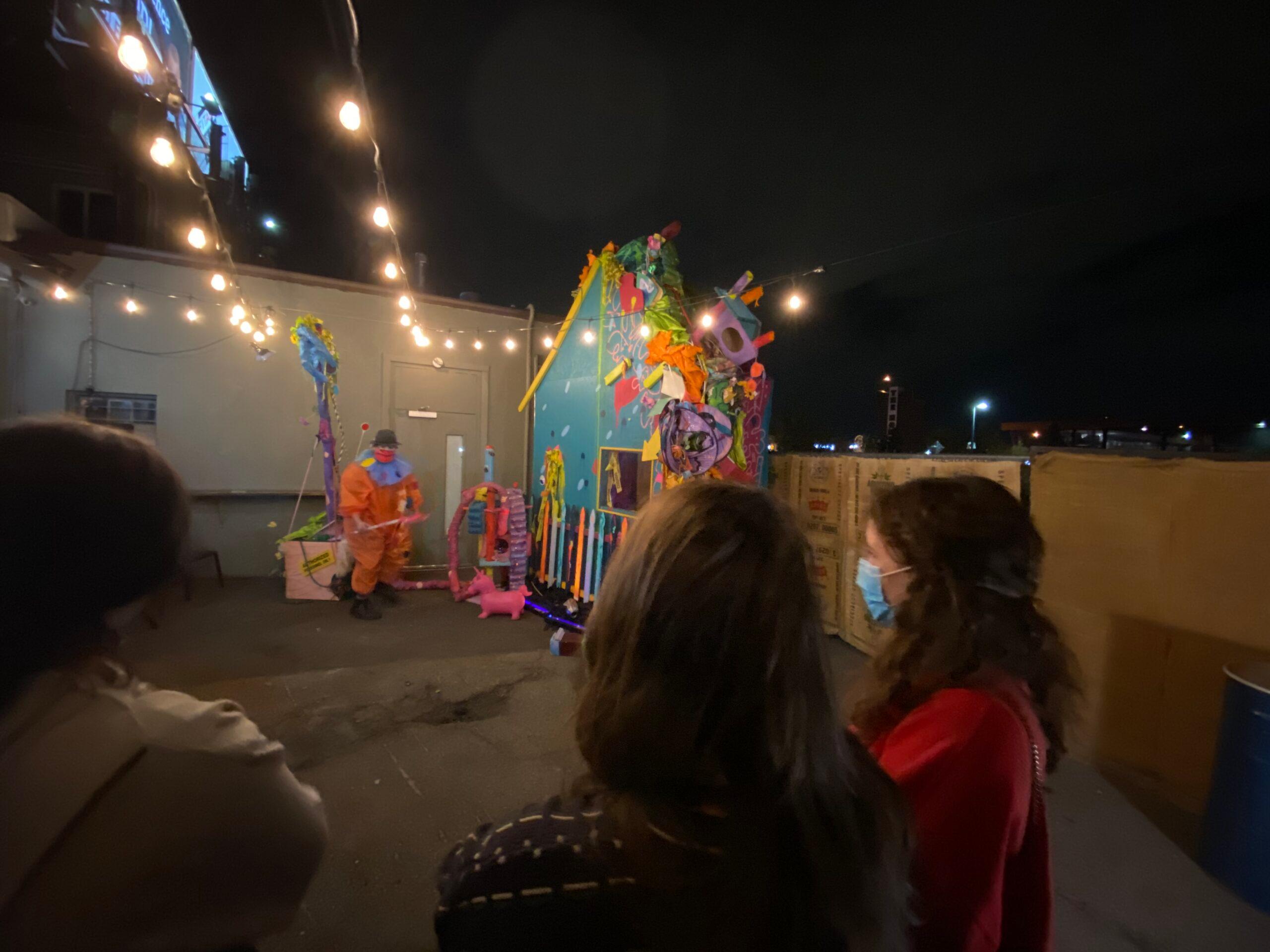


Chopra noted that we're living in hard times. If it weren't for COVID-19, we'd gather in communities to perform and experience art and have a shared conversation around what's happening in our country.
"And we can make it happen," she said.
Back in March, when they were discussing whether or not to go through with No Place to Go, they decided to approach COVID-19 as an obstacle that they'd have to work around creatively, rather than letting it crush the dream.
"I hope that the audience will feel that, the ways in which we created, despite the obstacles," she said. "And I feel like there is a lot of hope in that."
TIckets to No Place to Go are on sale now and are available Thursdays-Sundays at 6-10 p.m. on the following dates: 10/22, 10/23, 10/24, 10/25, 10/29, 10/30, 10/31, and 11/1. One $60 ticket covers a car of up to five people. There will also be virtual, 360-degree video tickets available in November for $25.
